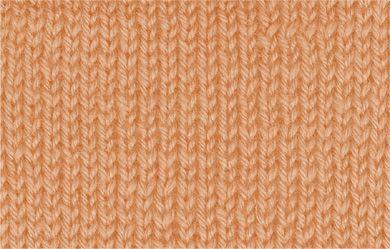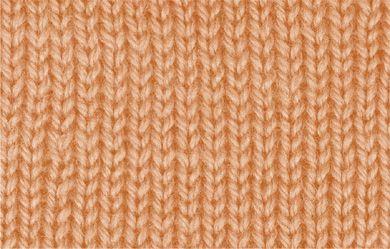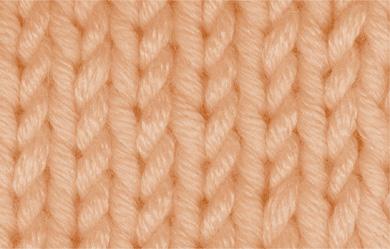Stitch 'n Bitch: The Knitter's Handbook (5 page)
Read Stitch 'n Bitch: The Knitter's Handbook Online
Authors: Debbie Stoller

Here are some of the most popular yarn fibers to knit with, and what makes ’em special:
W
OOL
Of course you know that wool comes from sheep. What you might not know is that different breeds of sheep yield different kinds of wool. Wool from Icelandic sheep, which grow long shaggy coats, for instance, is rough and can be scratchy, but it is as strong as nails. Merino wool is at the other extreme; it’s made from the superfine fleece of Merino sheep, and it’s as soft as cotton but has a tendency to “pill” (create little balls of fuzz). Merino is one of my favorite yarns to knit with—it’s not too expensive, and it feels great against your body.
M
OHAIR
This fuzzy, glamorous wool comes from the fleece of a goat—one that is confusingly called an Angora goat. But beware: Mohair can be itchy when it’s worn right next to the skin, so a mohair scarf might not be the best idea. On the other hand, a mohair tunic or cardigan would be right on.
C
ASHMERE
Cashmere is the most luxuriously soft and fluffy yarn of all, and it’s combed from the bellies of cashmere goats (now there’s a job I’d like to try). Cashmere is expensive, so, to make a sexy sweater that won’t break your bank, try a yarn that has cashmere blended together with something else, such as wool.

A
LPACA
Alpaca comes from a llama-like animal and it is exceedingly—some might say excessively—warm. That’s great for hats and scarves and mittens, but it could be overkill on a sweater, when you might be better off using an alpaca and wool blend.
A
NGORA
Sweater girls of the ’50s based their reputations on this stuff, which comes from bunnies—bunnies!—and is wonderfully fine and fluffy, like yarn made out of a baby’s hair. Unfortunately, angora yarn can also shed like a rabbit, so save it for accents like collars and cuffs, or try making one of those figure-flaunting sweaters using an angora-wool blend.
S
ILK
Silk comes from the long fibers of unraveled silkworm cocoons. It’s an extremely strong fiber—those silkworms are pretty clever—and yarn made from it is lustrous and shiny. Silk is also expensive, but its lightness makes it a great choice for a special summer item, such as a tank top or a shawl.
C
OTTON
Lovely, light, and absorbent, cotton is not as stretchy as wool, which means it can be a little harder to knit with. It also shows irregularities in your knitting more than wool does, so save it for when you’ve gotten pretty comfortable with the craft, then use it for a summer project, such as a bikini or light sweater.
L
INEN
Making cloth from linen goes back—and I’m talkin’
way
back—to around 8000
B.C
. Linen yarn is spun from the long fibers of the flax plant, and it’s super-strong and cool. Stuff knit with linen yarn can be
a bit stiff and will wrinkle easily, but I like this fiber just because it’s so ancient. It’s frequently blended with cotton, which makes it much easier to knit with. Use it for a simple project, such as a boxy tunic, and get in touch with your inner hunter-gatherer.
A
CRYLIC
Because it washes so well, acrylic yarn can be a great choice for projects intended for babies or pets. The fact that it’s inexpensive makes it a good choice for beginners or for anyone on a tight knitting budget. But try to buy a brand that has at least some wool blended in—it will be much nicer to knit with and to wear. And most of the coolest and weirdest new yarns—such as something called “eyelash” yarn, which has little bits of hair sticking out of it, or fuzzy, fake-fur types of yarn, or yarn with cool little bits of flotsam and jetsam mixed in—are made using acrylic. When it comes to having fun with these “novelty” yarns, I say put away your fiber snobbery and dive right in—the water’s fine.
Yarn Weights
To make things more interesting, yarn also comes in a variety of thicknesses, called “weights.” To complicate matters further, there are American and British names for each of these weights. Also, grouping yarns by weight is somewhat less than exact—there can be a lot of variety within one category. Still, knowing a yarn’s weight is important because if you ever want to use a different yarn than the one called for by your knitting pattern, you’ll want to look for yarn of the same weight. (For best results, though, always check your gauge, see
page 51
.) Here are five of the most common yarn weights (alternative names are given in parentheses):
Fingering (or baby or 4-ply) weight:
This very thin weight of yarn is good for making light, fine garments such as baby sweaters, socks, or a lacy shawl.

Fingering weight
Sport (or double-knitting or DK) weight:
Now here’s a very curiously named yarn weight. I mean, just what kind of sports item would you make out of this stuff? A knit jock strap? Sport weight yarn is roughly twice as thick as fingering yarn, so at least “double-knitting” makes sense. It is a good weight for socks and also works well for baby or children’s items. Many adult sweaters are also made out of it, albeit thin ones.

Sport weight
Worsted (or Aran) weight:
Despite its name, “worsted” might very well be considered the
best
yarn out there—it’s certainly the most common weight, and there are more kinds of worsted-weight yarn on the market than anything else. Worsted is about twice the thickness of sport yarn (Aran is just a tad heavier), and it’s great for making scarves, hats, sweaters, gloves, afghans, or just about anything else you want. It’s a great choice for beginners. Get to know worsted-weight yarn: It is your friend.

Worsted weight
Chunky (or bulky) weight:
The plot thickens. Chunky and bulky yarns are around twice as thick as worsted, and they knit up quickly on larger needles, making them great for heavy sweaters, such as Icelandic yoked sweaters, or thick gloves or scarves.

Chunky weight
Extra-bulky (or super-bulky) weight:
When it’s time to bring in the big guns, use extra-bulky yarn. This fat, almost ropy stuff is thicker even than chunky, and that’s why I recommend it for knitters with attention deficit disorder: Its bulk makes it possible to knit up a sweater in a weekend. A word of caution: If you’re the type of gal who is more likely to be described as “full-figured” than “willowy,” stay away from these yarns for anything other than accessories. A form-fitting sweater in extra-bulky yarn worn on a zaftig figure is the next best thing to wearing a fat suit. You’ll end up looking like a barrel, and you will not like it. Trust me—I’m speaking from experience here.

Extra-bulky weight
Usually yarn comes in
balls
(relatively round) or
skeins
(oblong), and if you’re lucky, you will have what’s called a center-pull ball or skein: The yarn will all come out of one end, and the ball won’t bounce and roll around so much when you’re knitting. Finding this end, however, can be tricky; often it is hidden under the yarn label. You might need to go poking around inside the left or right end of the ball to find it. If all else fails, just knit with whatever loose end you can find.

